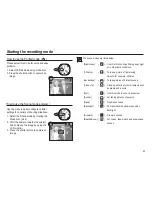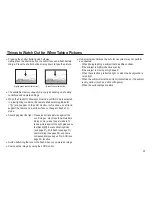
19
Starting the recording mode
Digital Image Stabilisation (DIS) mode.
This mode will reduce the effect of camera shake and help you get
a well-exposed image in dim conditions.
1. Select the DIS mode by rotating the mode dial.
2. Point the camera towards the subject and
compose the image by using the LCD
monitor.
3. Press the Shutter button to capture an image.
How to use the DIS mode (
)
You can manually con
fi
gure all functions
aperture value and shutter speed.
How to use the Manual mode (
¸
)
1. Select the MANUAL mode by rotating the
mode dial.
2. Press the Fn button and menu for the
shutter speed and aperture value will
display.
Up / Down button : changes aperture
value
Left / Right button : changes shutter
speed.
3. Press the Fn button twice and take an
image.
Things to watch out for using the DIS mode
1. The digital zoom will not operate in the
DIS mode.
2. If the lighting condition is brighter than
fl
uorescent lighting conditions, the DIS
will not activate.
3. If the lighting condition is darker than in
fl
uorescent lighting conditions, camera
shake warning indicator (
Ã
) will display. For best results only
take pictures in situations where the camera shake warning
indicator (
Ã
) is not displayed.
4. If the subject is moving, the captured image may be blurred.
5. Avoid moving the camera while the [Capturing!] message is
displayed to achieve a better result.
6. As the DIS uses the camera's digital signal processor, it may
take a little longer for the camera to process and save the
images.
7. If the image size is (
;
) or (
.
), the DIS mode can’t be selected.
Smaller Aperture values make the object sharp but blur the
background. Larger Aperture values make both the object and
background sharp.
High Shutter speeds can capture a moving object in a still image
as if the object is not moving. Low Shutter speeds can capture a
moving object with an ‘active’ effect.
















































